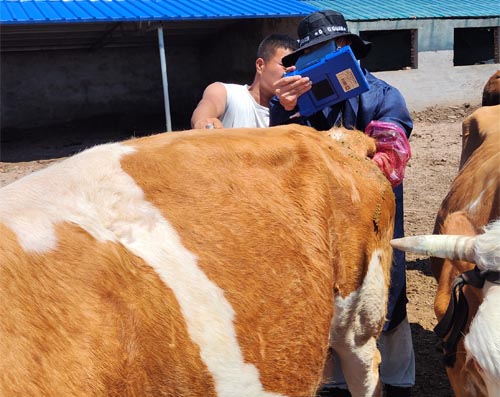There are many and complex diseases in dogs, and not all diseases can be diagnosed by imported B-ultrasound EVO. Now, several types of diseases with distinctive significance in B-ultrasound diagnosis are described as follows.
Imported B-ultrasound EVO detection of space occupying lesions on the body and surface of dogs
Occupying lesions refer to the growth and accumulation of pathological tissues that do not normally exist between normal tissues, occupying the original position of normal tissues, thereby affecting the normal development and function of the body. Tumors, hematomas, abscesses, cysts, cerebral hydatids, etc. can occur on the surface of the body, as well as in deep tissues and internal organs. However, regardless of where they occur, their structure is always very different from normal tissues. Ultrasound can precisely detect their existence, location, size, and even properties through cross-sectional images, playing the role of a "scout" and providing accurate and effective information for the overall elimination of them.
Imported B-ultrasound EVO detection of effusion lesions in the thoracic, abdominal, pericardial, ventricular, and luminal organs of dogs
One major feature of ultrasound is that it is almost completely absorbed or penetrated when encountering liquid tissue during propagation, without producing reflected echoes, thus showing a liquid dark area on the ultrasound sectional image. When there is fluid accumulation in areas where it should not normally occur, B-ultrasound accurately displays it and can show the degree of fluid accumulation and the tangible components mixed in the liquid. Such as pleural effusion and ascites; Pericardial effusion and lateral ventricular hydrocephalus; Pelvic hydronephrosis, bile duct fluid dilation, pathological accumulation of gallbladder or bladder, upper intestinal fluid accumulation during intussusception obstruction, uterine pyogenic fluid accumulation, etc.
Imported B-ultrasound EVO detection of canine biliary, urinary, and gastrointestinal stone lesions
Gallbladder stones, bile duct stones, kidney stones, bladder stones, urethral stones, intestinal stones, etc. are mostly caused by the deposition of minerals on the core material, which condense into relatively dense stone masses or mud and sand. They form ultrasound interfaces with surrounding tissues or liquids with greatly different impedances, forming highly echogenic light clusters or spots in B-scan ultrasound images, often with acoustic shadows. As long as the location is accurate during exploration, it is not difficult to confirm. The three major characteristics for diagnosing stone disease are strong echo light clusters, acoustic shadows, and possible displacement due to changes in body position.
Imported B-ultrasound EVO detection of substantial organ tissue and visceral lesions in dogs
When solid organs such as the liver, spleen, muscles, lymph nodes, and testes undergo hardening, calcification, softening, or liquefaction, the ultrasound echo of the affected area is either enhanced or weakened compared to adjacent healthy tissues or similar organs on the opposite side. In ultrasound diagnosis, this is referred to as a substantial echo change.
Imported B-ultrasound EVO detection of canine heartworm disease and cardiovascular disease
Canine heartworm disease is widely distributed in China, caused by the parasitic infection of canine heartworm in the right ventricle and pulmonary artery. Defects in the interventricular septum, interventricular septum, and interventricular septum, as well as stenosis and regurgitation of the tricuspid and mitral valves, are commonly encountered in clinical practice and are difficult to diagnose. M-mode echocardiography and ultrasound Doppler detection techniques are one of the fast and effective methods. Most B-ultrasound machines have the function of M-ultrasound and can also make diagnoses.
Imported B-ultrasound EVO detection of gastrointestinal foreign bodies and invasive foreign bodies in dogs
Dogs are omnivorous and active animals. It is not uncommon for them to accidentally swallow toys such as children's toys, glass balls, wool balls, nylon ropes, tape, etc., which can cause gastrointestinal foreign bodies or even obstruction in clinical practice. Esophageal obstruction caused by dogs eating bones, radishes, etc. is also common. It is necessary to make judgments on the size, location, and characteristics of foreign bodies or obstructions, and B-ultrasound can achieve this goal. After being pricked with needles, bamboo sticks, glass pieces, iron wires, etc., they are often transferred and deeply buried between the muscles. It is helpful to use ultrasound to determine their accurate position before surgery and then perform surgery.
Muscle, tendon, and joint injuries in racing dogs, military police dogs, and working dogs are crucial for limb movement. Ultrasound can assist in the diagnosis of muscle, tendon, and joint injuries. Ultrasound can make characteristic diagnoses such as muscle or tendon rupture, ectopia, joint exudation, and thickening of joint capsule.









